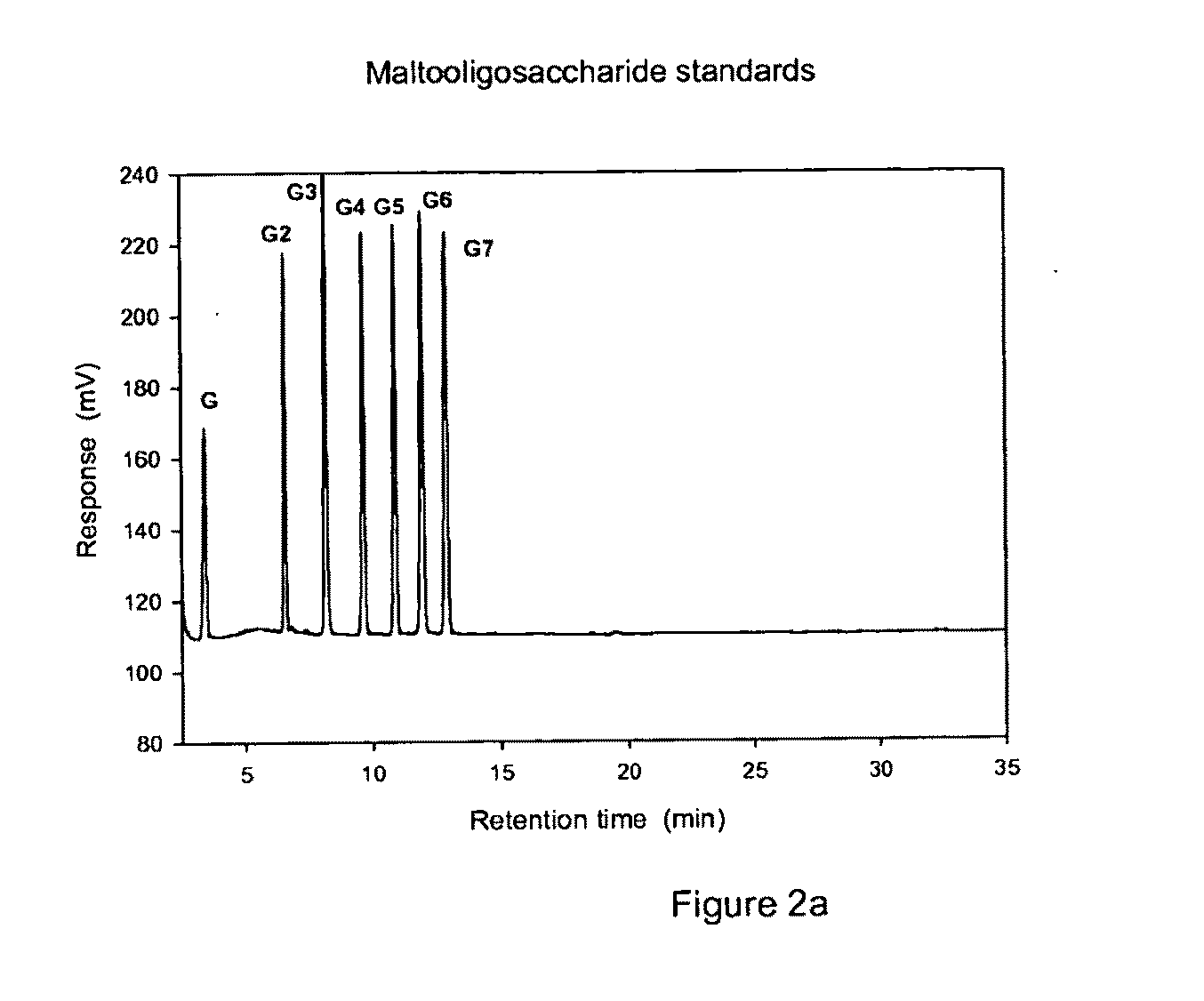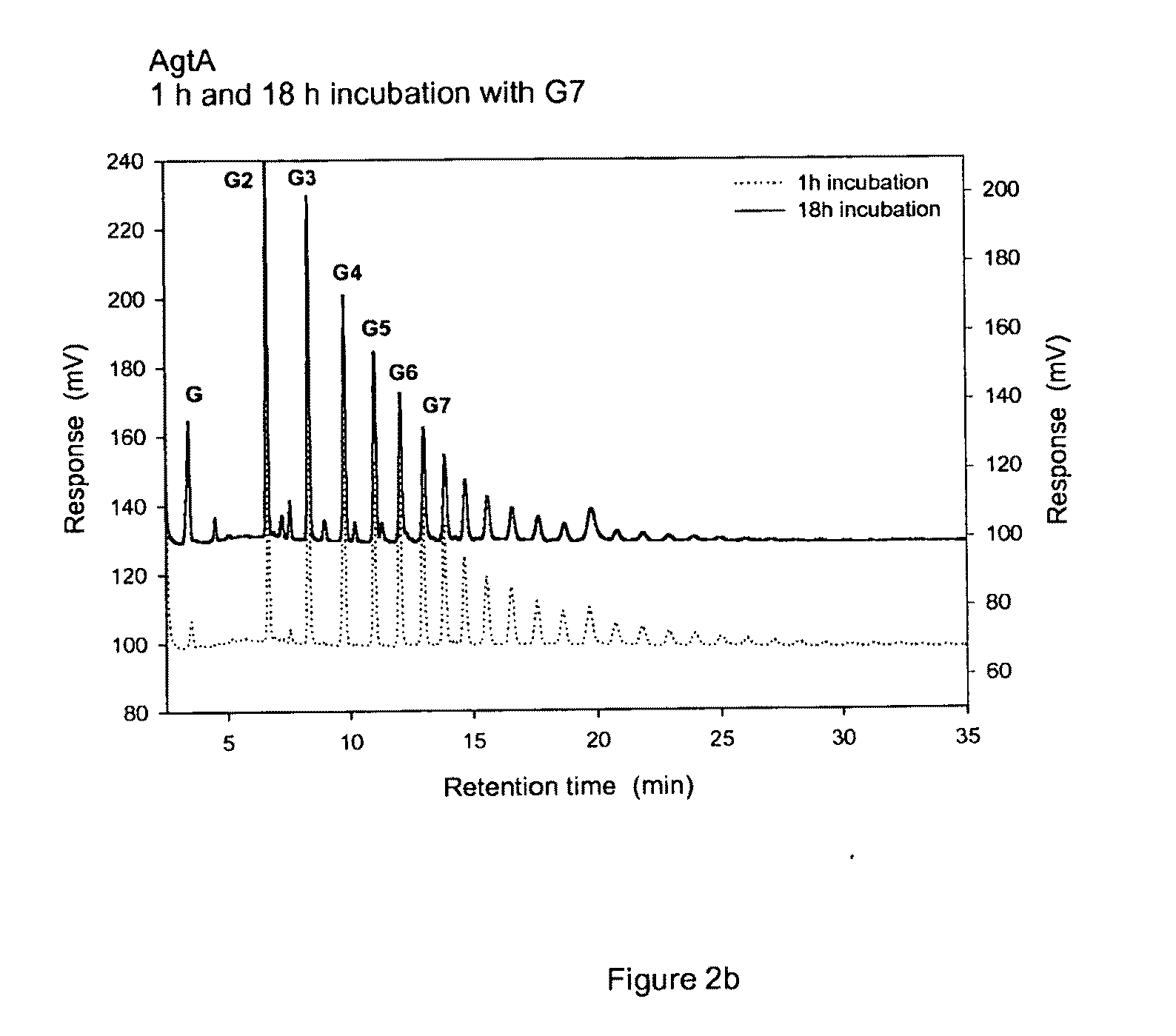Glucanotransferase
a technology of glucanotransferase and enzymes, applied in the field of glucanotransferase enzymes, can solve the problems of loss of typical starch characteristics, formation of free monomeric sugars, and inability to demonstrate catalytic activity
- Summary
- Abstract
- Description
- Claims
- Application Information
AI Technical Summary
Benefits of technology
Problems solved by technology
Method used
Image
Examples
example 1
Identification of AgtA, AgtB and AgtC
[0155]The full genome sequence of Aspergillus niger strain CBS 513.88 (available from DSM, The Netherlands) was used as the starting point. A Hidden Markov model (HMM) profile was built using the HMMER package (Durbin & Eddy (1998), Biological sequence analysis: probabilistic models of proteins and nucleic acids. Cambridge University Press) based on the sequences of known fungal α-amylases, which were retrieved from the CAZY website (http: / / afmb.cnrs-mrs.fr / CAZY / ). The profile was used to screen the A niger CBS513.88 genomic database using the WISE 2 package (Birney et al (2004) Genome Res 14, 988-995). The presence of a signal peptidase cleavage site and a glycosylphosphatidylinositol (GPI)-attachment site were predicted by web-based search tools (http: / / www.cbs.dtu.dk / services / SignalP / and http: / / mendel.imp.univie.ac.at / sat / gpi / gpi_server.html). Amino acid sequence alignments were made using ClustaIX (1.83) and Genedoc (version 2.6.002) and adj...
example 2
Cloning of AgtA and AgtB
[0157]All basic molecular techniques were performed according to standard procedures (Sambrook et al (1989) Molecular cloning: a laboratory manual. Cold Spring Harbor press, NY). E coli TOP10 (Invitrogen, Carlsbad, USA) or DH5α (Statagene, La Jolla, USA) were used for transformation and amplification of recombinant DNA. Primers were obtained from Eurogentec (Seraing, Belgium) or Biolegio (Nijmegen, The Netherlands). All steps during the construction of the expression vectors were checked by restriction analysis, and the final plasmids were checked by sequencing (GATC Biotech AG, Konstanz, Germany). Genomic DNA was isolated from A niger N402 and NRRL3122 as described (Kolar et al (1988) Gene 62, 127-134). All PCR reactions were performed with 2.5 units of Pwo DNA polymerase (Roche, Indianapolis, USA), 1× buffer and 1 mM of each dNTP in a total volume of 25 μl. A cDNA library was produced from A niger N402 grown on mineral medium containing starch as the sole c...
example 3
Production of AgtA and AgtB
[0158]A niger strain M00029-ΔaamA (Weenink et al (2006) Appl Microbiol Biotechnol 69, 711-717) was used as a host for protein over expression. This strain, derived from strain MGG029 (prtT glaA::fleor pyrG) is deficient in the expression of several extracellular proteases. It also has no glucoamylase gene (GlaA) and acid amylase gene (aamA) resulting in very poor growth on starch. Aspergillus strains were grown in Aspergillus Minimal Medium (MM) or Complete Medium (CM) which is MM with addition of 0.1% casaminoacids and 0.5% yeast extract (Oxoid, Basingstoke, UK). Cultures meant for protein production were grown in CMS (CM supplemented with 3% (w / v) sucrose). Spores were obtained by growing A. niger on CM supplemented with 2% agar for 4 days and scraping off the spores with 0.9% (w / v) NaCl. Liquid cultures were inoculated with 106 spores I−1 medium, and subsequently grown at 30° C. while shaking at 280 r.p.m. Transformation of A. niger was performed as des...
PUM
| Property | Measurement | Unit |
|---|---|---|
| Fraction | aaaaa | aaaaa |
| Fraction | aaaaa | aaaaa |
| Fraction | aaaaa | aaaaa |
Abstract
Description
Claims
Application Information
 Login to View More
Login to View More - R&D
- Intellectual Property
- Life Sciences
- Materials
- Tech Scout
- Unparalleled Data Quality
- Higher Quality Content
- 60% Fewer Hallucinations
Browse by: Latest US Patents, China's latest patents, Technical Efficacy Thesaurus, Application Domain, Technology Topic, Popular Technical Reports.
© 2025 PatSnap. All rights reserved.Legal|Privacy policy|Modern Slavery Act Transparency Statement|Sitemap|About US| Contact US: help@patsnap.com



